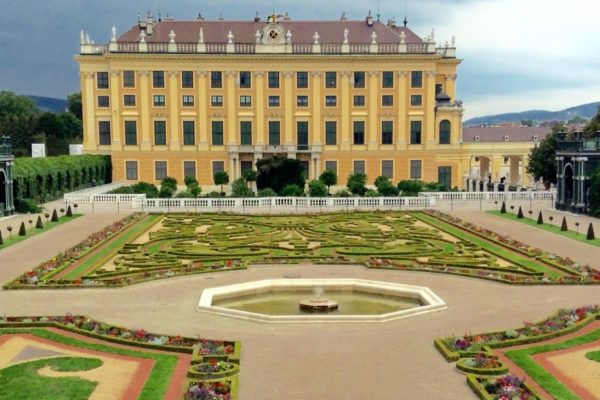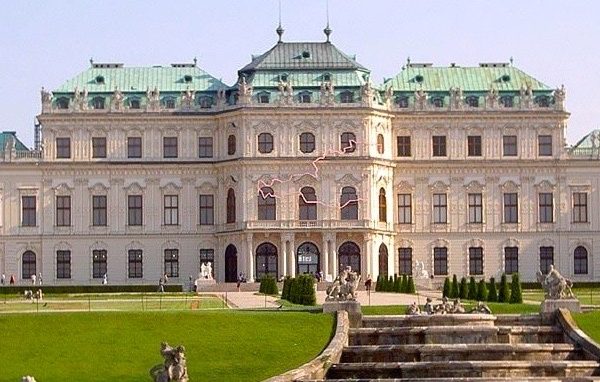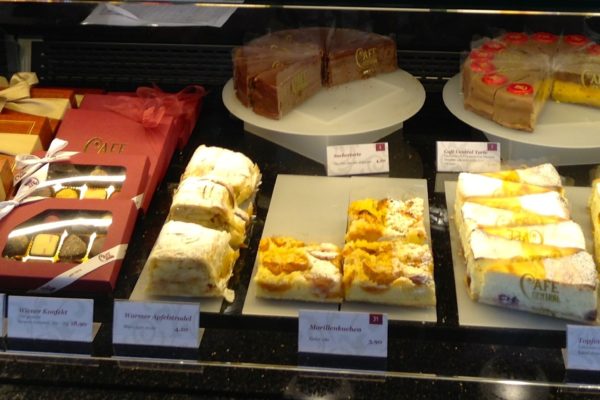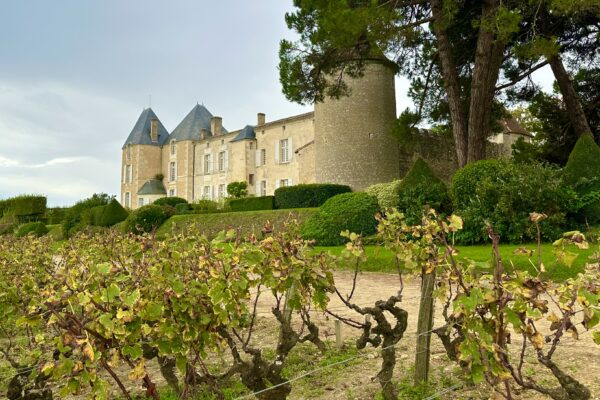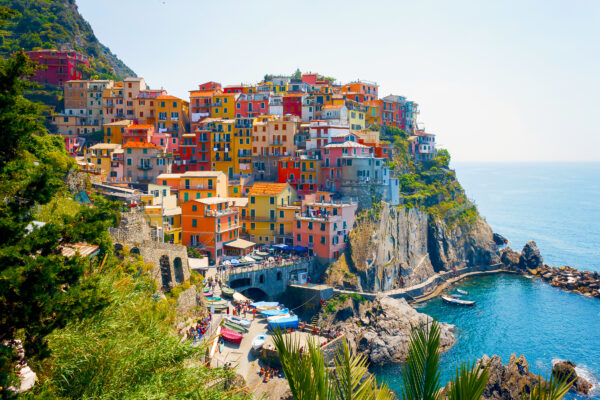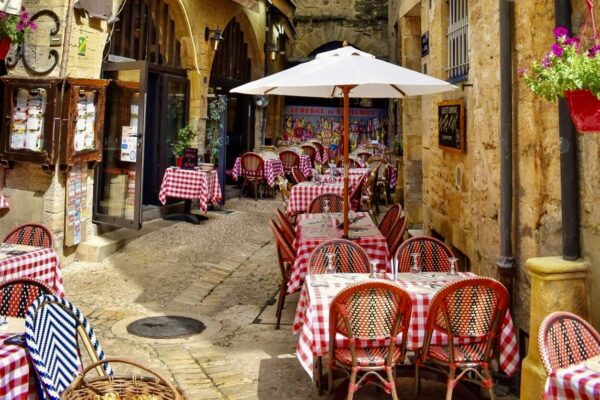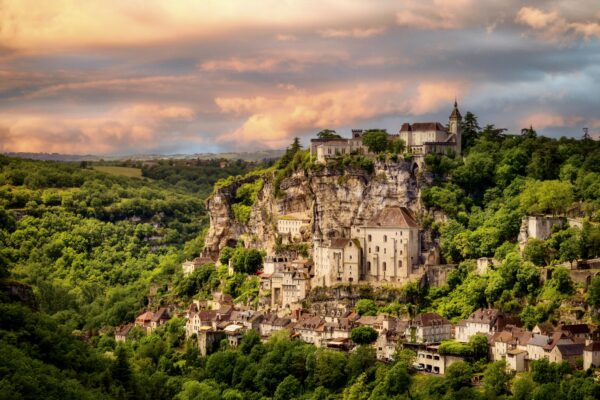Wein (Wine) City
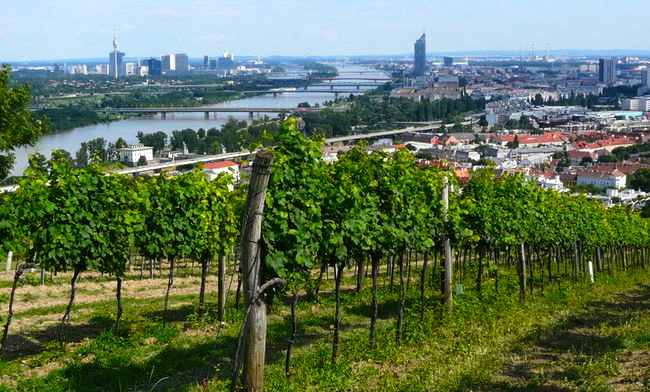
Vienna is Europe’s only metropolis with a wine region within the city limits.
Text and photos by Stetson Robbins, Sales Manager for Blue Danube Wine Company
Wien or Vienna, as us English speakers call it, is an ancient pre-Roman city of Imperial grandeur, and authentic rural charm. The cultural and political capital of Austria, a country that evidently spends more on arts than their military, Vienna feels at once smart and human. In addition to grand classicist architecture, definitive museums, the finest classical and operatic theaters, iconic coffee houses, mystical parks and gardens, authentic cuisine, progressive universities and street art; it is also Europe’s only metropolis with a wine region within the city limits. The region is known simply as Wein. Fast, clean, easy to use public transportation, a friendly largely English-speaking population, it takes only a long afternoon for the city to blow your mind.
GET YOUR GEMÜTLICHKEIT AT THE HEURIGER!
Gemütlichkeit is the cheerful, social atmosphere typical of Vienna’s Heuriger (Hoy-reh-gah). Part wine tavern, part picnic, part concert and part wine shop the Heurigers are quintessentially Viennese. Heurig means “this year’s”. Their beginnings date back to the late 18th Century when Holy Roman Emperor Joseph the II, one of the three Enlightened Monarchs, gave permission to the local farmers to sell their wine privately. Today, as then, the vineyards drape the hills of Nussberg and Bisamberg that overlook the city center. Between the city and the hills are streets of Heurigers, uniting the cosmopolitan and the country.
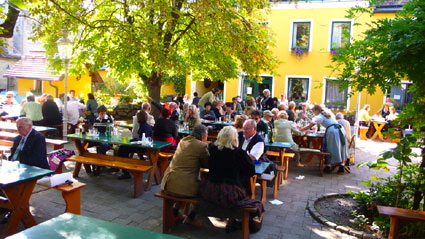
Lively crowds at a Viennese Heuriger.
Variations do exist, but the traditional Hueriger observes a few simple but important rules. No recorded music! Homemade food! Homemade wine! While simple the idea makes sense. Who should know how to sell and also enjoy a wine better than the people who make it. Some operate year round, but any are most completely experienced during the Summer, when festivities move outdoors.
In the winter the Hueriger are a respite from the cold. For centuries the Viennese and their GEMfriends have escaped the hustle of the city to unwind and buy bottles or even barrels of the current vintage to take home. The unyielding affection the Viennese have for the Heuriger has in a most beautiful way, preserved these familial businesses and in doing so protected a delicious and traditional wine type, Gemischter Satz.
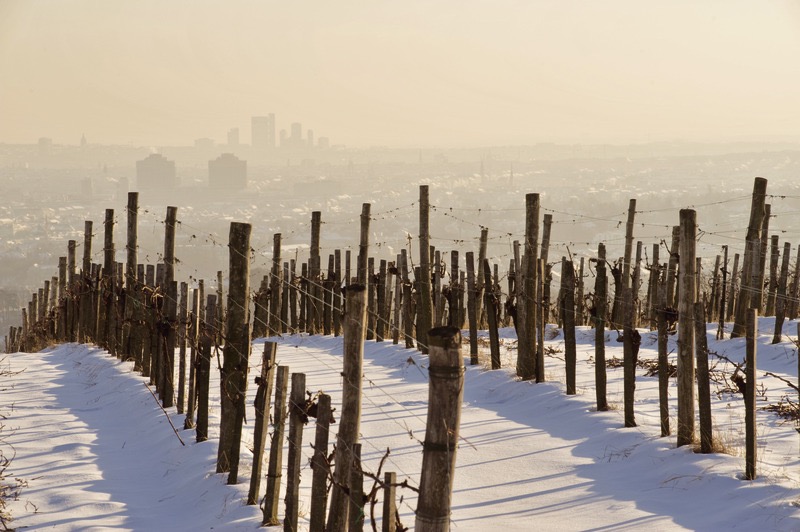
Snow-covered vineyards during winter.
Gemishter-what??? Gemischter Satz (Geh-meest-er Saw-tz) means “mixed set”, it is Vienna’s wine specialty. A true field blend of mixed grape sorts, it was until relatively recently regarded as a peasant wine. Long ago resourceful grape growers respecting the old adage “don’t put all your eggs in one basket” realized they could mitigate Vienna’s cool, but periodically erratic continental climactic conditions by growing a range of grape varieties that ripen at different times to produce wine of a higher average quality. A traditional sort of wine largely unknown outside of Vienna we can assume that the existence of Gemischter Satz today must have something to do with the Heuriger. Or maybe it’s the other way around. Whether it was the chicken or the egg, no wine better embodies the cheerful festive atmosphere of the Heuriger.
“Gemischt” as many call it for short is designed to make you smile and laugh, to toast and to drink. Naturally, as a field blend it varies widely in form producer to producer and vintage to vintage. Fruity, aromatic and highly drinkable is to be expected. The best examples are wines of considerable dimension and longevity, often sourced from special old vineyards of known and unknown sorts. Wines that manage to be serious, even world class, while sacrificing none of their inherent Gemütlichkeit. We wine lovers are fortunate not to have lost this vinous gem. Gemischter Satz captures all the whimsy, and grandness of Viennese culture, it is literally and figuratively Vienna in a glass. Rooted in history, diversity and social engagement it is a wine for everybody.
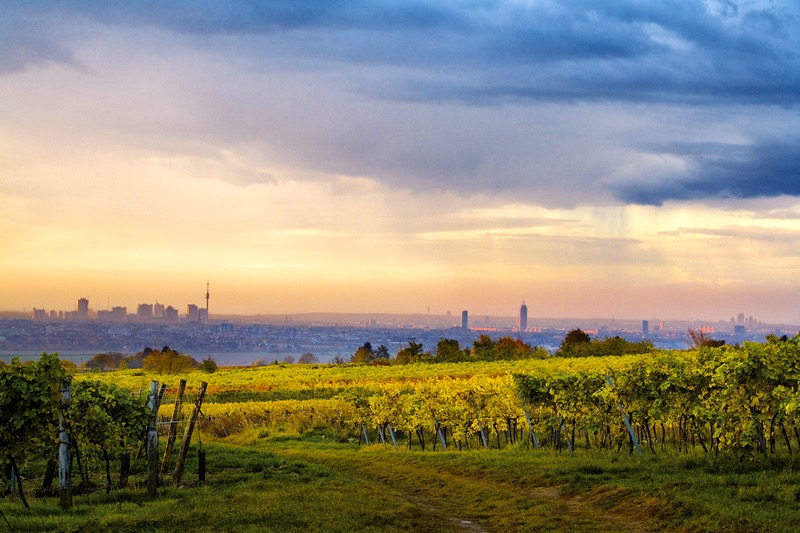
Grapes ready for harvest, with Vienna in the distance.
Today strict rules govern the production of Gemischter Satz. Most importantly that wine must be made from a minimum of three grape varieties planted, harvested and vinified together. No one grape variety can constitute more than 50% of the blend and the third no less than 10%. Varieties must be white. Gruner Veltliner, and Riesling, dominate, but many, many native and non-native, aromatic and non-aromatic grapes can be found in the vineyards. It is seriously mixed. In addition to the traditional Gemishter Satz, there are straight Viennese Gruner Veltliner, Riesling and pinot variety wines and small quantities of cool climate red wine that all can be quite good and distinctly Viennese in style. For more on Wein the Austrian Wine Marketing Board has you covered.
BERNREITER WINES
Peter Bernreiter is a master Hueriger’er. Meaning not only are his wines excellent but so is the Hueriger he runs. Or that he and his mother run, since she is still really boss. She raised him alone in the same house their family has lived in, in the wine village of Groß-Jedlersdorf for more than 200 years. They have always maintained a small vineyard there. Agriculture has forever been the family business. Peter’s grandparents were selling livestock and operating a general store when they were married in 1919 and a large dowry of vineyards was given to them.

Master Hueriger’er, Peter Bernreiter.
At this time the family Heuriger was opened. In the 1960’s Peter’s mom closed the general store to build a bigger Heuriger. In the 1980’s Peter took over the winery and has since doubled their vineyard holdings to more than 30 acres with a new winery. Quite a lot of land for a Wien producer considering the number of farming families and that there are only 1400 total acres in the region.
In 1980 Peter graduated with a degree in viticulture from Klosterneuburg, but was more interested in business. Interestingly a wine scandal in the mid-eighties involving some unscrupulous larger producers made room in the market for smaller quality-oriented wine makers and led Peter back out to the fields. Vienna’s environmental consciousness is also a part of its wines. Increasingly the Bernreiter vineyards as well as many other Wien producers are cultivated based on ecological criteria. Of equal importance is land management with natural vegetation to prevent erosion. Peter’s wines are critically acclaimed in Austria and increasingly abroad, but the truest experience is to have him pour you a glass of “Gemischt” to the sounds of Opera and happy people. Visit Peter!
Watch this brief video for a virtual visit to Peter Bernreiter’s Hueriger.
If you are interested in purchasing the Bernreiter wines in the U.S., they can be found through Blue Danube Wine Company. Additionally, look out for the wines of his neighborhood Wine Club J5. They are excellent as well.

“Travel Curious Often, its all in the name! An impassioned resource for genuine travel enthusiasts.”
– Stetson Robbins
Sales Manager, Blue Danube Wine
Stetson Robbins is the Blue Danube Wine Co. Sales & Distribution Manager for New York & the East Coast. Stetson and his wife Kristyn relocated to Brooklyn, New York in the Summer of 2012, to further the East Coast efforts of Blue Danube Wine Co. Stetson joined the team in Spring of 2008 as the first dedicated Southern California sales person. His obsession with wine is credited to a life-long interest in the institution of dining and his studies of Greek wine culture while earning a degree in Theater Arts at Long Beach State, where he acted in, directed, wrote and produced plays.
For Stetson, wine is part of an aesthetic total that brings together nature, culture, history and the human desire to share. He posses vigorous tasting habits and has spent considerable time abroad with wine producers. In addition to sales and distribution, he develops content for the website and regularly hosts tastings for both professionals and consumers, with equal enthusiasm. When not exploring New York’s vast food and wine scene, he can be found in the kitchen with Kristyn or running, playing golf, skating half pipes and trying to find surf in New York.
Also see Stetson’s article on Hungarian Tokaji, featured in the TCO Budapest issue. and Slovenian Wines.




